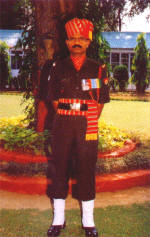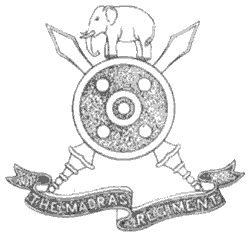 |
- Regimental Centre: Wellington, Tamil Nadu.
- Regimental Insignia: An Assaye Elephant posed upon a shield with two crossed swords.
- Motto: Swadharme Nidhanam Shreyaha (It is a glory to die doing one’s duty).
- War Cry: Veer Madrasi, Adi Kollu, Adi Kollu (Brave Madrasi, kill, hit and kill).
- Regimental Tribute:
Let those who come after, see to it that these names be not forgotten,
For they who at the call of duty, left all that was dear to them,
Endured hardships, faced dangers, and finally passed out of sight of men,
In the path of duty and self-sacrifice,
Giving their lives that we might live in freedom.
- Regimental Battalions: 2nd Battalion (old 75th Carnatic Infantry)
.................................3rd Battalion (old 79th Carnatic Infantry)
.................................4th Battalion (old 83rd Wallajahbad LI)
.................................5th Battalion
.................................6th Battalion
.................................7th Battalion
.................................8th Battalion
.................................9th Battalion (former State Forces unit)
.................................10th Battalion
.................................11th Battalion (old Territorial Battalion)
.................................12th Battalion (old Territorial Battalion)
.................................16th Battalion (former State Forces unit)
.................................17th Battalion (former State Forces unit)
.................................18th Battalion (former State Forces unit)
.................................19th Battalion
.................................25th Battalion (old garrison battalion)
.................................26th Battalion (old garrison battalion)
.................................27th Battalion (old garrison battalion)
.................................28th Battalion (old coastal defence battalion)
- 1st Battalion ------> 1 Mech. Inf.
|
|
Post-Independence
- Battle Honours: Tithwal, Punch, Kalidhar, Maharajke, Siramani and Basantar River.
- Honours & Awards: 1 Ashok Chakra, 5 Maha Vir Chakras, 32 Vir Chakras, 97 Sena Medals, 9 Param Vishisht Seva Medals, 7 Kirti Chakras, 17 Shaurya Chakras, 1 Uttam Yudh Seva Medal, 16 Ati Vishisht Seva Medals, 32 Vishisht Seva Medals, 151 Mention-in-Despatches, 210 COAS's Commendation Cards, 140 GOC-in-C's Commendation Cards, 3 Jeevan Rakshak Padak and 2 Unit Citations (3 and 25 Madras).
- Comments: The Madras Regiment today stands firmly and proudly on the deep rooted foundation of valour and sacrifice displayed by the warriors of South Asia. The four great kingdoms of Chalukyas, Cholas, Pandiyas and Cheras ruled various parts of South India till the end of 9th Century AD. Medieval India saw the rise of the Cholas whose empire extended from West Bengal in the east to south of Bombay in the west and covering the entire South India less the Cheras in Travancore and encompassing the islands of Sri Lanka, Malaysia, Cambodia and Sumatra. The soldiers of the Madras Regiment are the descendants of the Pallavas, Cholas, Pandiyas, Telugus and Cheras whose history of valour is unparalleled. The origin of the Madras Regiment in its present form can be traced to the occasion when the levies were organised into companies of 100 men each, and two battalions were thus raised on 4 December 1758 and placed under the command of Colonel (later Lord) Robert Clive to defend Fort St. George at Madras. Thus the Madras Regiment became the oldest element of Indian infantry. The number of battalions of the Regiment soon increased to a maximum of 52 battalions in 1826.
In a significant event, influencing the turn of history, the Madras Native Infantry spearheaded the storming of Seringapatnam Fort in the Fourth Mysore War in 1799. On 23 September 1803, the Madras Army under Marquise Wellesely defeated the Peshwa army at a place called Assaye and won the acclaim of all. In recognition of the fierce fighting capabilities displayed during the battle of Assaye, the insignia of an Assaye Elephant was awarded to the Madras Native Infantry and the same is worn on the belt by all ranks of the Regiment to this day. Despite outstanding services rendered during many wars, as part of the overall reductions during the period 1870-1903, the Regiment was reduced to 20 battalions and another 15 battalions were converted to First, Second and Eighth Punjab Regiment. Between 1923-28 on grounds of economy, the Regiment was further reduced to only four Territorial battalions and one University Training Corps battalion.
After independence, the infantry battalions of the Travancore, Cochin and Mysore State forces were amalgamated into the Madras Regiment. Post-independence saw the consolidation of the Regiment and re-affirmation of the versatility and valour of the South Indian troops when the battalions of the Regiment fought fierce battles during the 1947-48 Jammu & Kashmir Operations, the 1962 Sino-Indian Conflict and the Indo-Pak Wars of 1965 and 1971. The deployment of as many as seven battalions of the Regiment in Sri Lanka during Operation Pawan in 1987-89 was a testimony to the faith the Indian Army reposed in the loyalty, dedication and valour of the troops of the Madras Regiment. Two battalions (3 and 25 Madras) of the Regiment have been awarded unit citations by the COAS in recognition of their splendid service in combating insurgency in Jammu & Kashmir and Punjab. Further two battalions served the nation, in the world's highest battlefield in the subzero temperatures of Siachen Glacier.
|

